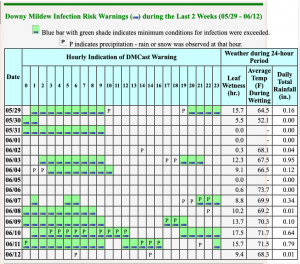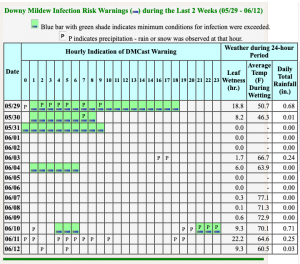It looks like we all received much-needed rains, which is good for vine growth. However, since most of our vines are still within the critical period for cluster infection by downy mildew, powdery mildew, and black rot (~ until 6 weeks after bloom for V. vinifera, ~ 4 weeks for V. labrusca), it also means that we may have had risk events for disease infection. Since the month of May was dry, I think the overall disease risk is low for downy, black rot, and other diseases that are driven by rain (e.g., ripe rot and Botrytis), but I just want to go over recent NEWA outputs.
Disease risks from the recent rain events
Westfield (Close to Bristol, VA)
It seems that the southwest VA received quite a bit of rain over the past two weeks! I would think many cultivars are close to the end of the critical period, but if you are concerned, a DMI fungicide and a Ridomil or Phos-acid product are effective for black rot and downy mildew, respectively. These materials can be applied a few days after the rain (2-3 days for downy, 3-4 days for black rot) to stop the ongoing infection process.
I would not take Phomopsis risks very seriously at this time of the season unless you have a heavy infestation (i.e., you see Phomopsis infection on rachis and berries very often). Most of our vineyards are relatively clean in terms of Phomopsis.
Richmond
(We cannot calculate downy mildew risks at Richmond because the station at Richmond is not a NEWA station.)
A daily summary shows precipitations starting from 28 May and as with Wakefield, they experienced frequent rain events. Please see the comment above.
Crozet
It seems that there was a gap of about ten days from previous rain events. If you are concerned about downy or black rot, please see the comments above.
I don’t know why powdery mildew risk is low. There were several days in the previous week that the maximum temperature was close to 90F, and maybe the model is reflecting it. However, since the daily average temperatures have been mid- to upper-70F, I think the powdery mildew pathogen is still active.
Winchester
The DMCast shows the risk of downy mildew was low, even though we had 22 hours of leaf wetness on the 11th. This is probably due to the low temperature. If you are concerned about black rot or downy mildew, please see the comments above.
What to do if you receive more than 1 inch of rain soon after you sprayed?
Due to the rain, I received several questions about actions after the rain. Typically, our general recommendation is to re-apply materials after 2 inches of rain or two weeks, whichever comes first. (Note: I often recommend a 7- to 10-day application from bud break to the end of the critical period since grapevines grow so quickly.) However, if you have more than 1 inch of rain, it is probably better not to wait for two weeks.
If you are interested, please check the article from Dr. Schilder about rain and wash off of fungicide. Her work suggests that although only a 0.04 inch of rain can wash a certain percentage of material from the leaf, it takes about 1-2 inches to actually causing a negative effect on the efficacy since the rate you apply is typically much higher than the threshold for the efficacy of the material. With the newly applied material, they observed good efficacy against Phomopsis from Captec and Ziram even after 2 inches of rain.
Another factor is whether you had enough time from the time of the spray and rain. In general, many fungicides we use require ~1.5 to 2 hours to be dry and adhere to the plant surface.
The take-home message here is that if you had 1-2 inches of rain soon after your previous application (with enough drying time), there is good efficacy left from the spray. I would not wait for two weeks, but you don’t need to rush out to re-apply immediately after the rain.
It probably depends on the sprayer, but if the rain started within an hour of your spray, you may need to go back and re-apply sooner than later.












